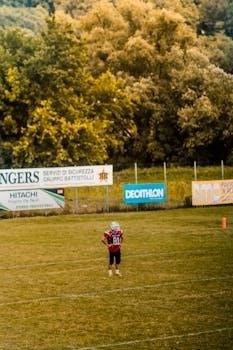
What is Field Day?
Field Day is a special event, a day of fun and games! It builds community and celebrates school culture. It is a day of physical activity, with classic races and relays. It creates memorable experiences for kids!

Benefits of Field Day Activities
Field Day offers many benefits. It promotes physical activity and builds community among students. It also fosters a positive school culture through teamwork and fun. These events encourage inclusivity and create lasting memories for everyone!
Promoting Physical Activity
Field Day is an excellent opportunity to get kids moving and engaged in physical activity. It offers a wide range of games and events suitable for all ages and abilities. These activities encourage cardiovascular health, improve motor skills, and promote overall fitness. From classic races and relays to innovative team challenges, Field Day provides a fun and engaging way for students to be active. It helps to combat sedentary behavior and instills a lifelong love for physical activity. By participating in Field Day, children develop healthy habits and build a foundation for a more active lifestyle, contributing to their well-being.
Building Community
Field Day promotes a sense of belonging and togetherness among students, teachers, and families. It offers an opportunity for everyone to come together and participate in friendly competition and collaborative activities. Through team-based games and events, Field Day encourages communication, cooperation, and mutual support. Students learn to work together towards a common goal, fostering a sense of camaraderie and teamwork. It provides a platform for students from different backgrounds to connect and build relationships. This helps break down social barriers and create a more inclusive and supportive school environment. It strengthens the bonds within the school community, creating a positive atmosphere.
Fostering Positive School Culture
Field Day is an opportunity to promote positive values such as sportsmanship, teamwork, and respect. By emphasizing fair play and encouraging students to support one another, Field Day helps create a positive and inclusive school culture. The event can also serve as a platform to celebrate the school’s achievements and recognize the contributions of students and staff. It provides a chance to showcase school spirit and pride, fostering a sense of unity; It encourages students to embrace healthy competition and learn from both successes and failures. It reinforces the importance of physical activity and healthy lifestyles, promoting overall well-being among students. It is a chance to create lasting memories.
Classic Field Day Games
Classic Field Day games are a staple of any successful event. These games, like sack races and relays, require little to no equipment. They are perfect for fun outdoors and bring lots of laughter!
Sack Races
Sack races are a timeless Field Day favorite, bringing laughter and friendly competition to participants of all ages. This simple yet entertaining activity requires minimal equipment⁚ just some large sacks, typically burlap or potato sacks. Participants step into their sacks and hold them up around their waists. Then, on the starting signal, they hop or jump forward towards the finish line. The first one to cross the finish line wins!
Sack races promote coordination, balance, and gross motor skills. They are adaptable for various age groups and skill levels. It can be modified to accommodate different abilities. They also provide an opportunity for students to cheer for their peers.
Three-Legged Races
Three-legged races are another classic Field Day game. They promote teamwork and coordination. This activity requires pairs of participants to tie one of their legs together. This forces them to work in sync to reach the finish line. Usually, a piece of string, ribbon, or velcro band is used to tie the legs together. The right leg of one student is tied to the left leg of their partner.
Communication and trust are crucial for success in this race. Partners must coordinate their steps. They should maintain balance to avoid falling. Three-legged races encourage teamwork and communication skills in a fun and active way. This makes it a staple activity in field days.
Relay Races
Relay races stand as quintessential Field Day events. They embody teamwork, speed, and friendly competition. These races involve teams of participants. Each member completes a designated section of the race before passing a baton or item to the next teammate. Relay races come in various forms. They can include running, hopping, or even carrying objects.
The core of a relay race lies in seamless transitions. Participants must quickly and efficiently pass the baton. This ensures minimal time loss for the team. Relay races are designed to foster team spirit, communication, and strategic thinking. They encourage participants to work together towards a common goal.
Water Balloon Toss
The Water Balloon Toss is a classic Field Day game. It is perfect for warm weather. This activity brings laughter and excitement. Participants pair up and toss a water balloon to each other. With each successful toss, the partners step further apart. This increases the difficulty. The goal is to see which pair can toss the balloon the furthest. They must do this without dropping or breaking it.
The game requires coordination and communication. Participants must be gentle yet accurate in their throws. This creates a fun and engaging challenge. It’s a fantastic way to cool off and enjoy some friendly competition.

Water-Themed Field Day Activities
Water-themed activities are a must for any Field Day! They bring refreshing fun to the outdoors. These games help students cool off in the sunshine. They add excitement and playful competition to the day!
Parachute Ball Pop
For Parachute Ball Pop, students pair off and line up about six feet apart. Eight to ten kids hold the edges of a parachute, tossing light plastic or foam balls on top. To begin, children start popping the balls up by making waves with the parachute, while adding more balls throughout the game to see how many can stay on before any fall out.
This parachute game brings laughter and builds teamwork. With teamwork, the balls will keep bouncing. Water balloon variations can add an extra splash of fun, keeping students cool and entertained under the sun. This is the ultimate game!

Team Building Field Day Activities
Team Building Field Day Activities fosters collaboration and communication. Activities require groups to work together towards a common goal. These activities promote problem-solving and strengthen relationships; Teams make memories while learning to depend on one another.
Team Bucket Challenge
The Team Bucket Challenge is an engaging team-building activity suitable for older kids and even adults, designed to promote collaboration and problem-solving skills. The challenge involves teams working together to transport water from one location to another using buckets with holes. Each team receives a set of buckets, ropes, and rings, requiring them to devise a strategy to minimize water loss during transport.
Communication is key as team members must coordinate their movements and efforts to efficiently fill, carry, and empty the buckets. The winning team is the one that successfully transfers the most water within a specified time frame, emphasizing the importance of teamwork and effective planning. This activity encourages creative thinking, cooperation, and friendly competition. This is a fun challenge!
Three-Legged Race (Team Variation)
The Three-Legged Race in a team variation elevates the classic game into a collaborative challenge, requiring pairs of students to synchronize their movements to achieve a shared goal. In this version, two participants stand side-by-side, and their adjacent legs are tied together using a piece of string, ribbon, or band. The objective is for each pair to walk or run together across a designated playing field, coordinating their steps to avoid tripping or falling.
This activity emphasizes communication, cooperation, and trust between partners, as they must work together to maintain balance and momentum. The first pair to successfully cross the finish line wins, highlighting the importance of teamwork and synchronized movement. This game is a fun and engaging addition to any field day.

Considerations for Planning a Field Day
Planning a Field Day requires attention to detail. Think about safety and involve volunteers. Choosing a fun theme will also enhance the day. Preparation ensures a smooth, enjoyable event for all participants involved in the field day.
Ensuring Safety
Safety is paramount when planning a Field Day. First, assess the playing area for hazards. Remove any potential obstacles that could cause trips or falls. Provide adequate supervision at each activity station, ensuring that volunteers are well-briefed on safety protocols. Consider the weather conditions and provide shade and hydration.
Establish clear rules for each game, emphasizing fair play and sportsmanship. Adapt activities to accommodate varying skill levels and physical abilities. Have a first-aid station readily available with trained personnel. Communicate emergency procedures to all participants and volunteers. Regularly check equipment for damage or wear.
Encourage participants to wear appropriate footwear and clothing. Implement a buddy system for younger children. Finally, ensure that all activities align with school policies and guidelines to minimize risks and promote well-being throughout the event.
Involving Volunteers
Volunteers are essential for a successful Field Day. Begin by recruiting a diverse group of parents, teachers, and community members. Clearly define roles and responsibilities for each volunteer, providing specific instructions for their assigned station or task. Organize a training session to familiarize volunteers with the activities, safety protocols, and overall event schedule.
Create a sign-up system to track volunteer availability and preferences. Communicate regularly with volunteers, providing updates and answering any questions they may have. On the day of the event, provide volunteers with clear signage, refreshments, and designated break areas.
Recognize and appreciate their contributions through thank-you notes, certificates, or small tokens of appreciation. Encourage volunteers to interact with students and create a positive and supportive atmosphere. By effectively involving volunteers, you can enhance the overall experience and ensure a well-organized and enjoyable Field Day for everyone involved.
Choosing a Theme
Choosing a Theme can elevate your Field Day from fun to unforgettable! A well-chosen theme provides a creative framework, uniting all activities and decorations under a central idea. Brainstorm themes that resonate with your school’s culture and the interests of your students. Consider popular movies, books, or historical periods.
Once you have a few ideas, assess their feasibility. Ensure the theme allows for a diverse range of games and activities that cater to different age groups and abilities. The theme should inspire creativity and promote inclusivity.
Develop decorations, costumes, and music that align with the theme. Encourage students and volunteers to dress up and fully immerse themselves in the chosen world. A theme can bring unity, excitement, and a sense of shared adventure.
It makes it more memorable! It is a great way to add an extra layer of fun and to show school spirit.